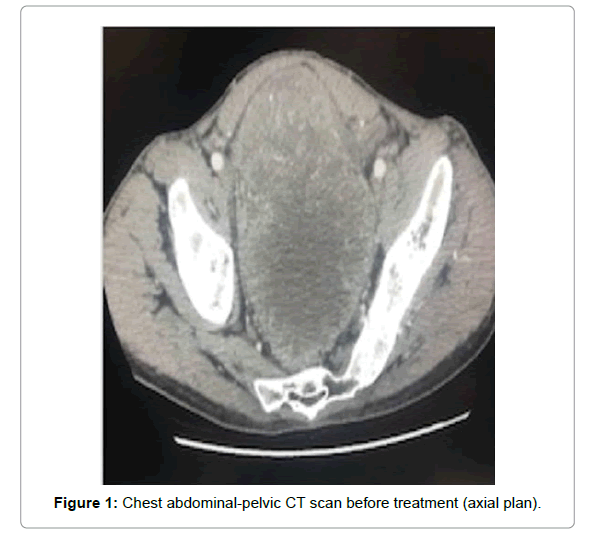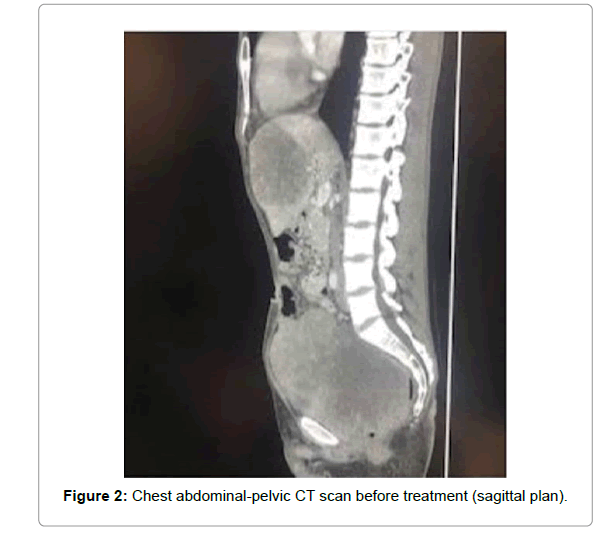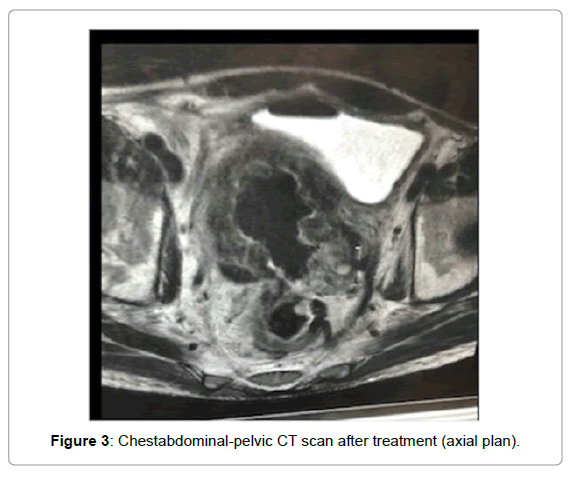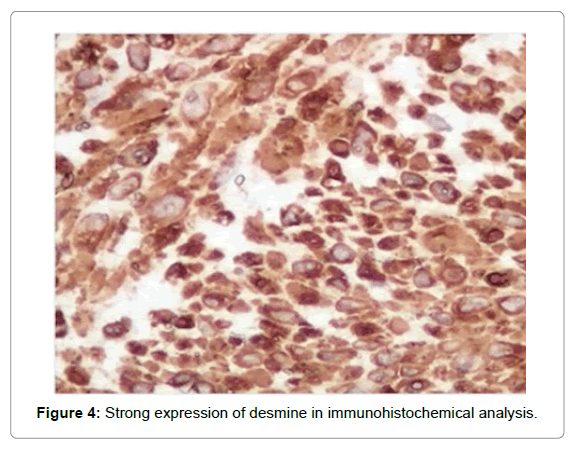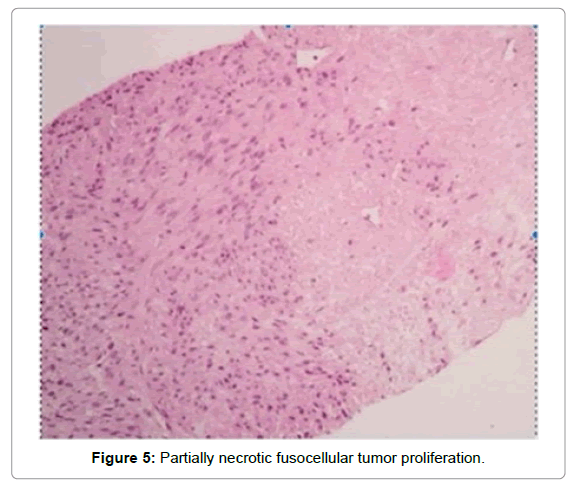Leiomyosarcoma of Prostate: Case Report and Literature Review
Received: 31-May-2021 / Accepted Date: 14-Jun-2021 / Published Date: 21-Jun-2021 DOI: 10.4172/aot.s2.1000002
Abstract
Historically, Leiomyosarcoma is a rare neoplasm with a poor survival rate. In Between June 2018 to January 2019, we treated a rare case of Prostate Leiomyosarcoma initially metastatic to the lung and the liver with multiple pelvic lymph nodes. Five cycles of chemotherapy and palliative radiotherapy have been delivered with a mean follow up of 1 year. Chest abdominal-pelvic CT scan with MRI and bone scan are necessarily to assess clinical staging.
The objective of this study is to review our experience in the management of Prostate Leiomyosarcoma at the Casablanca Cancer Center of Mohammed VI University of Health Sciences with a literature review of this rare neoplasm.
Keywords: Prostate leiomyosarcoma; Multimodal treatment; Genitourinary sarcoma; Onco-urology
Introduction
Prostatic Leiomyosarcoma is a rare primary tumor in adults representing 38% to 52% of primary prostate sarcomas that accounts for less than 0,1% of prostate malignancies. Its diagnosis is generally made at an advanced stage due to clinical and radiological none specificity, the prognosis remains poor. Chest abdominal-pelvic CT scan with MRI and bone scan are necessarily to assess clinical staging. The aim of this work is to present a rare case of Prostatic Leiomyosarcoma treated with chemotherapy and DE compressive analgesic radiotherapy with a literature review regarding the clinical features, diagnostic modalities and therapeutic aspects of this rare entity.
Case Description
A 40-year-old male patient without medical or surgical history of interest. He has presented since March 2017 rectal pain tension and burning with urination. Macro hematuria wasn’t detected; he hadn’t a family history of genitourinary cancer. On examination; the bladder was palpable and on digital rectal examination the prostate was asymmetrically enlarged with nodular variegated consistency. Urinary analysis and blood biochemistry reports were normal including prostate specific antigen (PSA=0.46 ng). On Trans-Rectal Ultra Sonogram (TRUS), prostate volume was 430 ccs with an ill-defined, heterogeneous, with an aspect of varicocele on the left and testicular atrophy on the right. The prostate biopsy and Immunohistochemical analysis (Figures 4 and 5) both revealed that the tumor was “Leiomyosarcoma of the Prostate”. On further evaluation with Chest abdominal-pelvic CT scan (Figures 1-3) it was seen that this large heterogeneous mass of the prostate presented irregular contours with area of infiltration of the bladder base and anterior rectal wall. Multiple presacral lymph nodes and pathological lesions have been observed in the liver and lungs. Bone scan was normal. After the multidisciplinary meeting the patient received palliative radiotherapy with a total dose of 30 Gy on 10 fractions five days per a week, on oncology hospitalization he had undergone 5 cycles of combination chemotherapy (Ifosfamide 1500 mg/m2 and doxorubicin at 50 mg/m2 for three days at three-weekly intervals) but he died 2 months after the last cycle.
What is already known on this topic?
Leiomyosarcoma of the prostate is an uncommon and highly aggressive tumor that accounts for less than 0.1% of primary prostate malignancies with median survival estimated in 17 months.
What this study adds
The goal of this study was to support the multidisciplinary approach (urology, radiation therapy and chemotherapy) for appropriate management of this devastating malignancy (Figures 1-5).
Results and Discussion
Leiomyosarcoma of the Prostate is a rare primary malignant tumor [1] histological type can be divided into prostate Leiomyosarcoma, rhabdomyosarcoma, fibro sarcoma and spindle cell sarcoma 2 with an average age of 58 years. The most frequent reason for consultation is a urinary obstructive syndrome including: Hematuria, burning with urination, perineal pain and weight loss as observed in our case [1,2]. Usually, most of the patients with a prostate sarcoma were diagnosed at an advanced stage in fact our patient has demonstrable metastases to the lung and to the liver as well these results in the lack of early specific clinical symptoms which impacts overall survival rate [2,3]. The dosage of prostatic markers (PSA, PAD) is typically normal because of histological type (not epidermoid) [4,5]. The pathological diagnosis, supplemented by an immunohistochemical study is essential for the classification of these tumors [1].
Recommendations regarding the management of prostate sarcomas weren’t sufficient and contradictory. Sen and associate [6] evaluated the results of 13 patients treated at the Mayo Clinic between 1970 and 1985, 10 patients were treated for the cure: 3 with Leiomyosarcoma, 2 with rhabdomyosarcoma and 5 with carcinosarcoma.
No distinction was made regarding the histological subtypes. All 3 patients who were treated with partial cystectomy had recurrence. Neither report systematically included chemotherapy in the management. In an attempt to improve survival for patients with Leiomyosarcoma of the bladder or prostate, adjunctive chemotherapy and radiotherapy were combined with surgical excision. However, the use of adjuvant chemotherapy increased cystic necrosis without actual tumor response. Post-operative radiotherapy was reserved for residual disease.
In our experience Leiomyosarcoma tends to be locally advanced before metastasizing. The mean follow up was approximately 1 year than the patient died. No clear-cut conclusions can be drawn with a tumor this rare. Palliative radiotherapy was indicated to reduce pain symptoms not for curative intention because the tumor was very extensive locally. It is interesting that the clinical response was apparent after chemotherapy making us believing that probably the combination of chemotherapy and an operation offer the best results for these aggressive tumors.
The CT scan and MRI make it possible to assess the local and general extension of the tumor. The radiological appearance of Leiomyosarcoma is not specific. It is generally a large heterogeneous tumor which can raise the bladder floor or invade it.
Endorectal ultrasound is superior in the assessment of local extension. The treatment of this tumor has not yet been codified, it includes surgery, pre or postoperative radiotherapy and neoadjuvant or adjuvant chemotherapy with anthracyclines, alkylating agents and alkaloids as appropriate. It depends on age, general condition, tumor volume, grade of malignancy and extension workup [7]. The prognosis of prostatic Leiomyosarcoma is often unfavorable. Survival is very variable depending on the series. It is on average less than 10% in 5 years.
Conclusion
Adult prostatic Leiomyosarcoma is a rare tumor, often metastatic at diagnosis, with normal PSA levels. CT and especially MRI play an important role in the assessment of extension and post- treatment follow-up, but only the Prostate biopsy supplemented by immunohistochemical analysis can confirm the diagnosis. Their therapeutic management is not currently codified, and their prognosis remains very poor and can only be improved with a multi-disciplinary approach and early diagnosis, making it possible to perform complete radical surgery, the only effective therapy.
Competing Interest
The authors declare they have no competing interest.
Authors Contribution
All the authors contributed in this study.
References
- Cheville JC, Dundore PA, Nascimento AG, Meneses M, Kleer E, et al. (1995) Leiomyosarcoma of the prostate: Report of 23 cases. Cancer 76: 1422-1427.
- Sexton WJ, Lance RE, Reyes AO, Pisters PW, Tu SM, et al. (2001) Adult prostate sarcoma: The MD Anderson cancer center expérience. J Urol 166: 521-525.
- Janet NL, May AW, Akins RS. Sarcoma of the prostate: A Single institutional re-view. Am J Clin Oncol
- Morse MJ, Whitmore WF (1989) Genitourinary sarcomas in adults. In Surgical Management of Soft Tissue Sarcomas. Philadelphia: Lea and Febiger.
- Narayana AS, Loening S, Weimar G W (1978) Sarcoma of the bladder and prostate. J Urol 119: 72-76.
- Sen SE, Malek RS, Farrow GM, Lieber MM (1985) Sarcoma and carcinosarcoma of the bladder in adults. J Urol 133: 29-30
- Ruiz MC, Escudero JC, MartÃnez JIP, Cortiñas JR, González J, et al. (2001) Prostatic Leiomyosarcoma. Report of a case a review of the literature. Actas Urol Esp 25: 445-449.
Citation: Benali I, Allaoui M (2021) Leiomyosarcoma of Prostate: Case Report and Literature Review. J Oncol Res Treat S2:002. DOI: 10.4172/aot.s2.1000002
Copyright: © 2021 Benali I, et al. This is an open-access article distributed under the terms of the Creative Commons Attribution License, which permits unrestricted use, distribution, and reproduction in any medium, provided the original author and source are credited.

